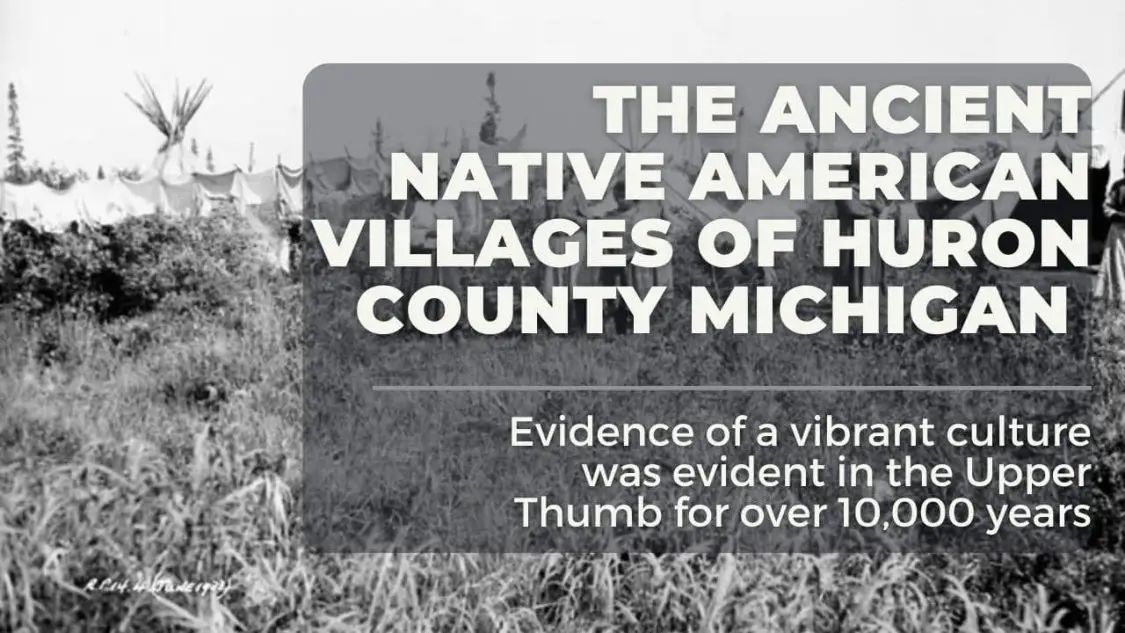Upon its ninety miles of shoreline were numerous Michigan Indian villages and camps. These were found due to the debris left by the dwellers. The Indians in Huron County, Michigan, had a village site every few miles along the shore and islands of Saginaw Bay. A vibrant culture was evident in the Upper Thumb for over 10,000 years.
What We Will Cover
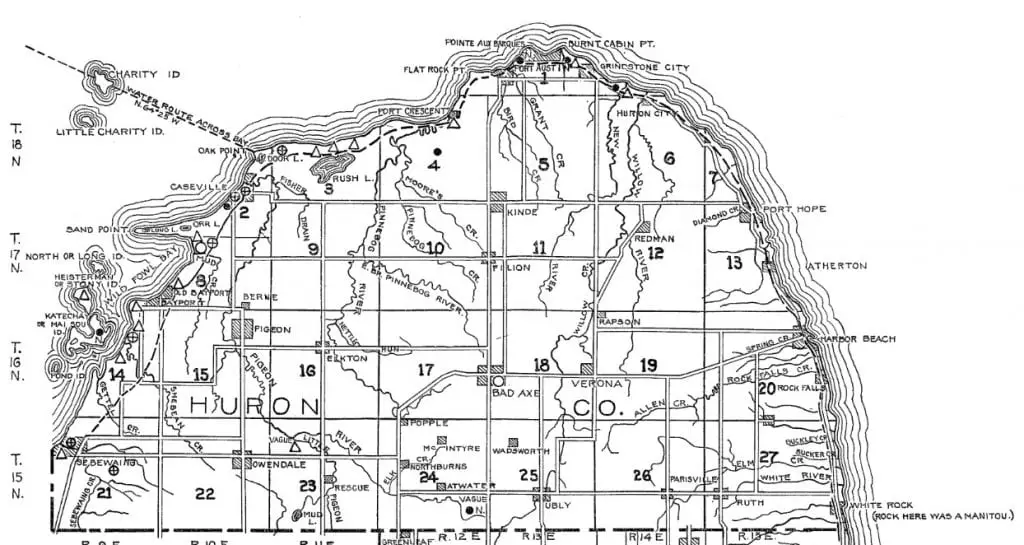
Chart Symbols
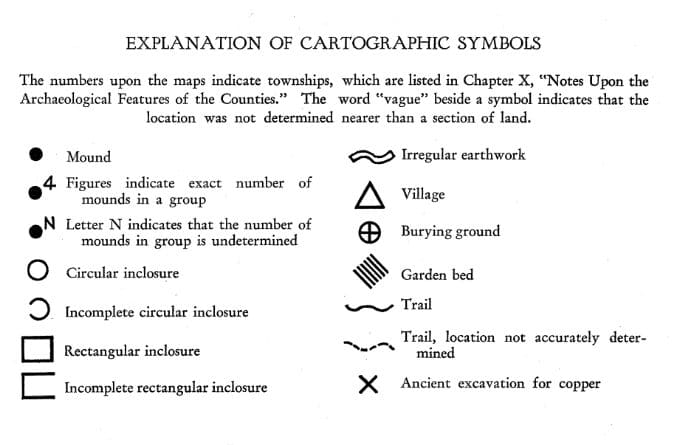
Michigan Indian Active History In Huron County
In Wild Fowl Bay, the small islands also have remains of villages and mounds. The remnants of mounds mutilated by relic hunters are visible within a mile east of Port Austin near the mouth of New River. A mound group was situated in the southeastern part of Sheridan Township, near the county’s southern boundary, but the section upon which it stood could not be ascertained.
In 1901 Mr. Harlan I. Smith of Victoria Memorial Museum, Ottawa, Canada, surveyed the Thumb and reported 1901 that a number of small mounds stood upon Katechay Island, Fair Haven Township. There is an old record of a circular enclosure where the courthouse at Bad Axe stands. Traces of workshops and camps were found along the Lake Huron shore. The SandRidge trail followed the shore from Oak Point, and a “ferry line” crossed the bay for Point Lookout and Au Sable River, a stopping-place at Charity Island. The Indians in Huron County, Michigan were active people with significant cultural artifacts that were left to find.
Sebewaing: An Indian Village
In 1901 a survey was conducted of the Thumb area by Harlan Smith, a noted Michigan archeologist. He noted:
A camp or small village was situated on the south side of the Sebewaing River and back from the flood-land which here extends along the shore of Saginaw Bay. It lay upon a low sand ridge near the first shaft of the Sebewaing Coal Company. Chipped points of chert, potsherds, and burned and crackled pebbles have been found in sufficient numbers to indicate the site (Smith, 1901:292).
This was the first survey and another was not conducted until 1931. It’s interesting to note that a major archaeological update has not been conducted since the 1930s.
SandRidge Indian Trail
Indian Sites and Artifacts
- Villages – 13
- Burying grounds – 7
- Mounds – 7
- Circular enclosures – 1
Major Indian Sites Described
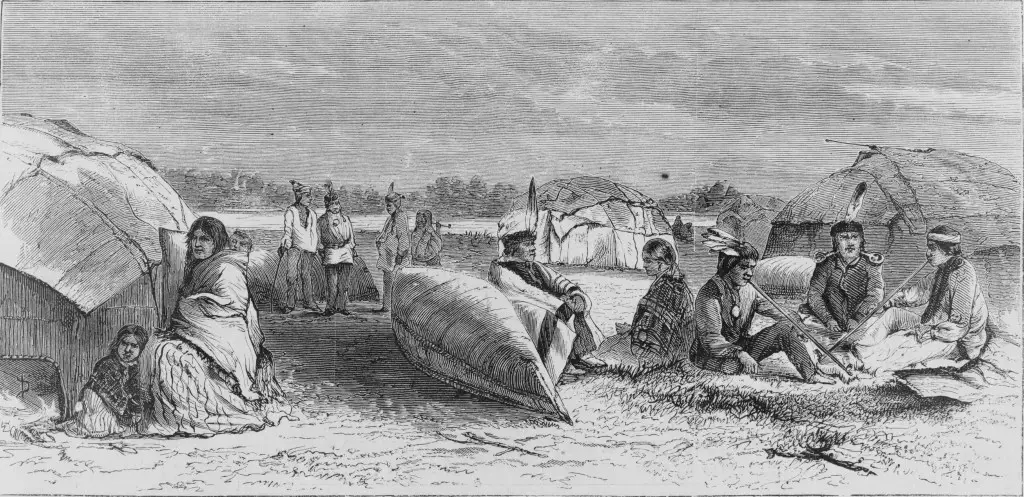
Coast Mounds of the Upper Thumb
Mounds along the northern coast, especially between Port Austin and Pointe Aux Barques, also between Grindstone City and Huron City.
Caseville Mounds
Large circular work in Caseville township on a small stream emptying into Wild Fowl Bay, 5 miles southwest of Caseville. “and as relating to ‘‘ large circular mounds.” The stream is probably Mud creek. The region near the eastern shore of Wild Fowl bay is low, with an occasional sand ridge, and is less than eight miles north of extensive outcrops bearing chert nodules
North Island Workshops
At the western limit of Wild Fowl bay is North island, on the northern side of the highest part of which are traces of workshops where chert implements may be found in all stages of manufacture – from the nodular masses occurring in the substratum of the entire island to the finished chipped points for spears, arrows, knives, and similar objects. Chipped implements of other materials have not been obtained at this place.
Heisterman Island Village Site
Lying next south of North island, at a distance of about a mile, is Heisterman island, where are many traces of an ancient village site in addition to pieces of evidence similar to those on North island. These are on the sand ridges the highest land-and on the northeastern side of the island ‘ where it slopes to the marshlands known as the Middle Grounds. These swamps are especially frequented by fish, and wildfowl assemble there in great numbers to feed on the wild rice. The rice alone, which does not grow off other portions of Heisterman island, may have determined the site of the prehistoric village.
The sub carboniferous series underlying the island outcrops on its western shore, within easy access of this site. Hammerstones chipped points for arrows, knives, spears, drills, etc., and chipped implements resembling flint hoes in shape, have been gathered here. Fragments of pottery, many of which are neatly ornamented (some by incised designs, others by cord impressions) and a fragment of a pottery pipe have also been found at this site
Near some of the villages, hidden deposits or caches have been found, fourteen in all having been discovered in the Saginaw valley. The specimens from a number of these may be seen in this collection. That the quarries from which the Indians obtained their raw material have yet to be found is possible because signs of them may have been obliterated by modern quarrymen or by the grinding of the ice or the beating of the surf against the lakeshore outcrops during the many years which must have elapsed between the time when the Indians abandoned the quarries and the time when the first archæologist saw the site
Mai-sou Island Mounds
Several similar mounds on Mason island southwest of Wild Fowl Bay.
Bay Port Village Site
A village or camp was located on the mainland and lay along the sand ridge which runs parallel to the beach of Wild Fowl bay at a distance of a few hundred feet; it extended at least half a mile to the east from the wharf at Bay Port. Chipped implements of chert in all stages of manufacture are frequent on the ridge. Potsherds, a gorget, one grooved maul, and a paint grinder were also found here.
Bay Port Cache
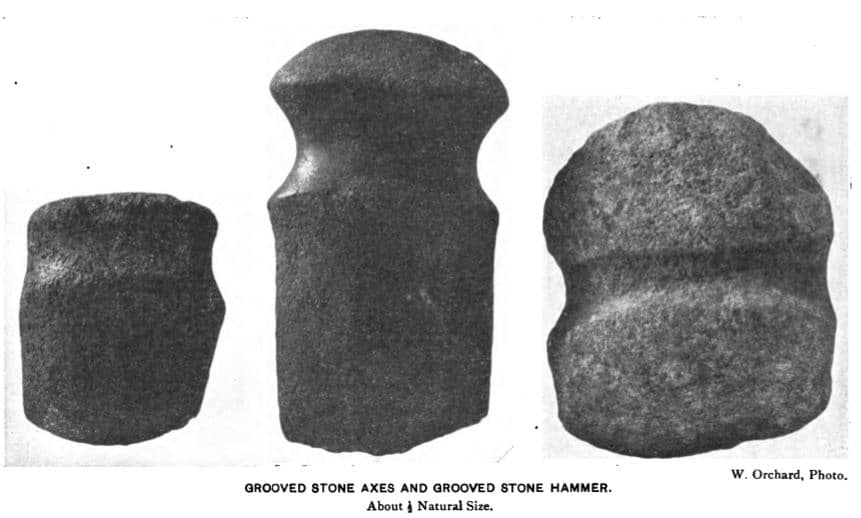
A cache consisting of one cross-section of a chert nodule and forty-seven “ turtle-back ” blanks, was found two feet below the surface in the muck jungle about 100 feet from the shore of Wild Fowl bay and a quarter of a mile east of the wharf at Bay Port.* The specimens in the cache were found in a row, overlapping one another somewhat like shingles on a roof. It is probable that the material of which they were made was obtained near the spot, as the outcrop of subcarboniferous rock, which occurs for some distance along the beach westward from the wharf, bears concretions the material of which is similar to that of the cache specimens.
There are several outcroppings of this rock within a mile. In this cache were blades of peculiar form, having a straight, beveled edge on one side. It seems probable that this was caused by flaking the pieces for “ turtlebacks ” from around concretion. The first flake removed would be perfect, but after that, if the material were used without waste, each flake would have one side beveled where the immediately preceding flake had been removed from the nodule. They had not all been subjected to sufficient secondary chipping to remove the signs of this bevel.
More or less evidence has been found of the existence of a number of village sites, burial – places, mounds, and prehistoric battlegrounds from Bay Port southward along the shore of Saginaw Bay, on the western shore of the bay, and along the lower course of Saginaw River. There are Ojibwa traditions also, which tend to confirm the archæological evidence.
From such sites, the quantity of material in this collection is not sufficient to warrant a detailed description of it in this place. This, however, is given in a summary of the Archäology of Saginaw Valley, Michigan, published in the American Anthropologist beginning with Part II, 1901.
The fragments of pottery, arrow- points, and other objects found on the surface of the sand ridges along the eastern side of Saginaw River in the city of Saginaw, indicate a number of village sites that were separated by bayous.
From one of the later series, there has been obtained one of the so-called “bird-shaped” stones which are evidently in process of manufacture. The greater portion of the surface shows the pits caused by ” pecking,” as it is technically called, that is, the bruising of the surface of the stone and the brushing away of the crushed particles until it has assumed the shape desired. At either side of what was to have been the head, the next process in the manufacture had been taken up, as is shown by the rubbed surfaces. It is probable that this rubbing was done with a rather coarse stone, and that the implement would have been finished by polishing.
Sharpsteen Village Site
The Indians of Huron County Michigan, were also found a Camp or small village located on Sharpsteen point, about half a mile west-southwest of the Bay Port village site. It was on a wide sand ridge of slight elevation. Potsherds, hammerstones, and chipped implements were numerous on the surface. A Celt in process of manufacture was also found here.
Sebewaing Village Site
A camp or small village was situated on the south side of Sebewaing river and back from the flood-land which here extends along the shore of Saginaw Bay. It lay upon a low sand ridge near the first shaft of the Sebewaing Coal Company. Chipped points of chert, potsherds, and burned and crackled pebbles have been found insufficient numbers to indicate.
Sebewaing Burial Place
No description is given specifically for this entry.
Pigeon River Mounds
“Large circular mounds at the head of Pigeon river, near the middle of the southern boundary of the county ”
Bad Axe Ring Earthwork
Bad Axe post office is on a circular mound or earthwork in a swamp, “a spot of dry land twenty or thirty feet above the level of the swamp, with a wall of the earth extending around it.”
Michigan Indian Source Bibliography
- Archaeological Atlas of Michigan Wilbert B. Hinsdale.
- Indian Village Image – Canada. Dept. of National Defence / Library and Archives Canada / PA-034816
- Prehistoric Michigan. Smith, Harlan Ingersoll, 1872-1940.
- Preliminary list of the sites of aboriginal remains in Michigan, by Harlan I. Smith
- Catalog of prehistoric works east of the Rocky Mountains, Thomas, Cyrus
Related Reading For Michigan Indians and Tribes
- Michigan Indian Trail of the Upper Thumb
- The Sebewaing Michigan Coal Mines
- Michigan’s Indian Trails
- Haunted and Spooky Sites in Michigan’s Thumb
- Indian Place Names in the Saginaw Valley and Michigan’s Thumb

